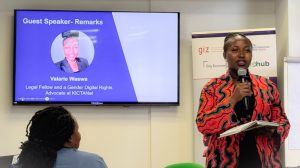Most of the world celebrated International Women’s Day with activities centred around women’s achievements and challenges in the virtual and physical world. This year’s theme was apt, DigitALL: Innovation And Technology For Gender Equality. In celebrating women in all their diversity, let us look at the state of digital coverage for women and girls with disabilities.
Women with disabilities encounter multiple intersecting barriers to digital access. These include gender norms leading to stereotyping and social stigma. Other challenges are digital accessibility and usability, online safety concerns, limited digital literacy, internet access, and lack of relevant content.
Gender Norms
Gender norms are the standards and expectations within a society, community, and culture about how individuals are expected to conduct themselves based on their perceived gender. The genders generally conform to these expectations.
Some community settings view mobile phones and the internet as a deviation from the traditional social order and a threat to the safety and reputation of women. As a result, many young women have to contend with “gatekeepers” in the family controlling their access to devices.
Another far-reaching consequence of gender norms is their influence on the design and development of digital and other tech products. These products are generically designed with male users in mind. Ultimately, we have technology that does not meet the needs and preferences of women with disabilities.
Caroline Criado Perez deconstructs the premise of the “Default Male,” in which processes and products are designed with the default man in mind. In her book Invisible Women, we can see examples of how women are missing from data sets across all aspects of life that inform how the world is designed.
Lastly, gender norms create inequalities in education and device access and discourage women from working and studying in tech-oriented fields. The digital divide that arises from these practices, especially for women with disabilities, creates inequalities in participation in our current digital societies.
Data on Digital Inclusion Gap for Women with Disabilities
Gender inequality in the physical world is replicated in the digital world. A report by UNICEF on the gender digital divide shows that women and girls, regardless of their state of disability, lag in embracing digital technology compared to men and boys.
The International Telecommunications Union (ITU) reported that over 50% of women globally are offline. This percentage is more pronounced in developing countries, where the internet penetration rate for adult women is 41%, compared to 53% for men.
In low to middle-income countries, the prevalence of disability among women is higher, comprising up to three-quarters of persons with disability. The prevalence of disability among women has been linked to gender-related risk factors, including exposure to violence, lack of access to sexual and reproductive health services, and harmful practices.
Limited digital skills mean that women and girls are particularly vulnerable to digital harm. The risks include various forms of online gender-based violence (OGBV). Online violence manifests as cyberbullying, online sexual exploitation of girls, and the non-consensual sharing of private information and images.
These risks are extended to data security, privacy, mobile device theft, and fraud. Persons with disabilities may have greater difficulty in identifying scams such as phishing and safeguarding personal information as it displays on their device screen. The fear of falling victim has resulted in many women limiting access to digital technology or staying away altogether.
The affordability of smartphones is frequently the greatest barrier because of low incomes and other disability-related expenses that take precedence. Because of the costs, women and girls with disabilities are less likely to own smartphones than their non-disabled counterparts. A well-configured smartphone has the potential to be an assistive technology and improve access to information and services for persons with disabilities.
Bridging the Gender Disability Digital Gap
Women with disabilities are missing out on the opportunities offered by digital connection. Opportunities to communicate and expand their community beyond their current environment and access information and services.
The way forward is to hold consultations with women and girls with disabilities to understand their digital challenges and what they need and want from a digital tool. Caregivers of girls and women with disabilities and other disability stakeholders can benefit from educational material on online gender-based violence and the guidebook to data protection and privacy.
Lastly, there are increased calls and efforts to make digital content and devices in formats accessible and usable for persons with disabilities. More advocacy and awareness of the need for digital content relevant to the needs of women with disabilities will hopefully bridge this gap. It is imperative to adopt inclusive design practices by including women with disabilities in the design and iteration process.
![]()




